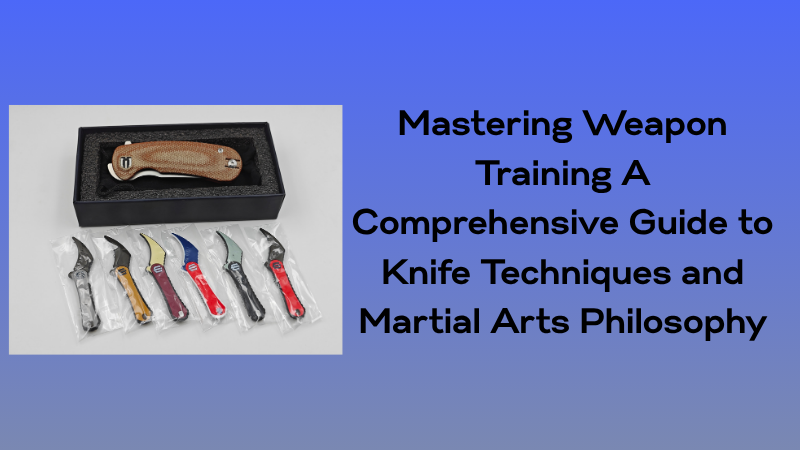
Mastering Weapon Training: A Comprehensive Guide to Knife Techniques and Martial Arts Philosophy
Introduction
Weapon training, particularly with knives, is an integral part of many martial arts disciplines. It not only enhances physical skills but also deepens the understanding of martial arts philosophy. This guide delves into the intricacies of knife training, exploring grips, strikes, and movements, while respecting the rich history and diverse traditions within martial arts.
The Importance of Grip in Knife Training
The grip is fundamental in knife training, affecting both control and effectiveness. Two primary grips are discussed here:
- Aggressive Forehand Grip: This grip emphasizes power and precision, suitable for offensive maneuvers. It involves holding the knife with the blade facing outward, allowing for strong, decisive strikes.
- Defensive Reverse Grip: This grip prioritizes defense and versatility, making it ideal for close-quarters situations. The blade faces inward, enabling quick, adaptive movements and counters.
Each grip has its advantages and should be mastered to adapt to various combat scenarios.
Basic Strikes and Angles with a Knife
Understanding the angles of attack is crucial for effective knife strikes. The primary angles include:
- Straight Downward Cut: Executed with a firm grip, this strike targets vulnerable areas and is effective in close combat.
- Diagonal Cuts: These cuts can be both offensive and defensive, targeting multiple areas with a single motion.
- Thrusts: Direct and powerful, thrusts are used to penetrate deeply, making them highly effective in self-defense situations.
Each strike requires precision and practice to ensure safety and efficacy.
Advanced Techniques and Movement
Advanced techniques involve fluid movement and coordination, enhancing the practitioner's versatility:
- Spinning and Rolling: These techniques add flair and functionality, allowing the knife to be used in various dynamic situations.
- Fluid Movement: Integrating knife techniques with body movement creates a seamless flow, essential for real-world applications.
Safety and control are paramount when practicing advanced techniques, especially for inexperienced practitioners.
Integrating Weapon Training with Empty-Hand Techniques
Martial arts training often emphasizes the integration of weapon techniques with empty-hand methods, fostering a holistic approach to self-defense:
- Unified Movement: The principles learned in empty-hand training, such as balance and coordination, complement weapon techniques, enhancing overall proficiency.
- Versatility: Mastery of both weapon and empty-hand techniques makes a practitioner more adaptable in different scenarios.
This integration underscores the martial arts philosophy of unity and balance.
Martial Arts Philosophy and Training Mindset
The mindset and philosophy guiding martial arts training are as important as the physical techniques:
- Focus and Discipline: Consistent practice and mental focus are essential for mastering any martial art.
- Respect and Continuous Learning: Acknowledging the value of diverse martial arts traditions fosters growth and understanding.
- Practical Application: Techniques should be applicable in real-life situations, emphasizing efficiency and effectiveness.
This philosophy ensures that martial arts remain a dynamic and evolving practice.
Safety Measures and Knife Maintenance
Safety is paramount in knife training. Proper handling and care of the knife are essential to prevent accidents and maintain the knife's effectiveness. Here are some tips:
- Proper Handling: Always handle the knife with care, ensuring that the blade is directed away from the body.
- Storage: Store the knife in a secure location, out of reach of children and unauthorized individuals.
- Maintenance: Regularly clean and sharpen the blade to ensure optimal performance.
The Controversy with Filipino Martial Arts
In discussing knife training, it's inevitable to touch upon the Filipino martial arts community. The user's past experience with this community highlights the sensitivity and passion surrounding martial arts traditions. It's important to approach such discussions with respect and an open mind, recognizing the value of diverse martial arts systems while maintaining a focus on practicality and effectiveness.
The Karambit: A Unique Weapon
The Karambit, a curved blade originating from Southeast Asia, is a unique weapon that offers both functionality and lethality. Its design, featuring a ring for finger retention, allows for versatile grips and strikes. Learning to use the Karambit involves understanding its history, proper grips, and effective techniques. Practitioners must also consider the legal and ethical implications of carrying and using such a weapon.
Expert Training and Insights
Experts like Jason, a pro knife thrower and martial artist, emphasize the importance of proper technique and mindset when handling knives. His insights into the Karambit and other knives highlight the need for continuous learning and the integration of knife techniques into a broader martial arts system.
Conclusion
Mastering weapon training, particularly with knives, is a journey that combines physical skill with philosophical insight. By understanding grips, strikes, and movements, and integrating these with empty-hand techniques, practitioners can achieve a higher level of martial arts proficiency. Embracing the rich diversity of martial arts traditions and maintaining a disciplined, respectful approach ensures continuous growth and mastery.
